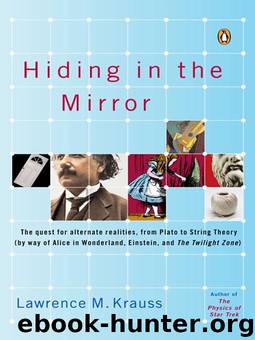Hiding in the Mirror by Lawrence M. Krauss

Author:Lawrence M. Krauss [Krauss, Lawrence M.]
Language: eng
Format: epub
Publisher: ePub Bud (www.epubbud.com)
Published: 2010-08-11T16:00:00+00:00
C H A P T E R 1 2
ALIENS FROM OTHER DIMENSIONS
. . . the banality of existence has been so amply demonstrated, there is no need for us to discuss it any further here. The brilliant Cerebron, attack- ing the problem analytically, discovered three distinct kinds of dragon: the mythical, the chimeral, and the purely hypothetical. They were all, one might say, nonexistent, but each nonexisted in an entirely different way.
—Stanislaw Lem, The Third Sally
If physicists have been fickle in their intermittent love affair with extra dimensions, turning hot and cold as their whims and desires evolved, artists and writers have been much more faithful with their affections. Through good times and bad, a literary fascination with another world beyond the reach of our senses has held steadfast. There is an unbroken string of writing with this focus, stretching from Lewis Carroll’s Through the Looking Glass (1872) to C. S. Lewis’s The Lion, The Witch, and the Wardrobe (1950) and beyond. These books, written almost a century apart, were ostensibly created for children by austere British academics, but both reach out far more broadly to that primal yearning to answer with a resounding no, Peggy Lee’s plaintive cry: “Is that all there is?”
Despite the gap in time and intentions of the writers (Carroll was, among other things, a satirist who poked fun at both authority and thenmodern mores, while C. S. Lewis wrote his tale as an allegory to promote his deep religious convictions), there is a remarkable similarity in their choice of dramatic method. Alice is transported through a looking glass to a new three-dimensional world that exists inside of the glass, but clearly not behind it. Lewis’s Lucy similarly enters a wardrobe, which again has a well-defined back when seen from the outside, but instead of encountering a wooden frame, she stumbles into the snowy night of that other threedimensional world, Narnia. From a mathematical perspective (and Carroll, at least, was a mathematician), what both young girls traverse is a mystical intersection between two completely separate three-dimensional worlds. To enter one is to disappear from the other . . . or at least in Alice’s case to disappear, once she turns the corner out of view of those peering into the mirror. And two separate and distinct three-dimensional worlds can intersect only if the underlying space is at least four-dimensional. As I have previously alluded, their experience is strangely reminiscent, if less terrifying perhaps, than little Christie’s experience in the Twilight Zone episode “Little Lost Girl.” Actually, this 1962 screenplay derived from an earlier short story by Richard Matheson that appeared in the science fiction magazine Amazing Stories in November 1953. The contemporaneous appearance of Matheson’s piece and Lewis’s allegory is perhaps not surprising, for just as the world of elementary particle physics was turning topsy-turvy during the 1940s and ’50s, so, too, did this period witness a resurgence of interest among writers, artists, and now filmmakers in a possible fourth spatial dimension. During this era and
Download
This site does not store any files on its server. We only index and link to content provided by other sites. Please contact the content providers to delete copyright contents if any and email us, we'll remove relevant links or contents immediately.
The Complete Stick Figure Physics Tutorials by Allen Sarah(6631)
Secrets of Antigravity Propulsion: Tesla, UFOs, and Classified Aerospace Technology by Ph.D. Paul A. Laviolette(3432)
Thing Explainer by Randall Munroe(3319)
The River of Consciousness by Oliver Sacks(2989)
The Order of Time by Carlo Rovelli(2708)
I Live in the Future & Here's How It Works by Nick Bilton(2520)
A Brief History of Time by Stephen Hawking(2471)
How To by Randall Munroe(2465)
The Great Unknown by Marcus du Sautoy(2180)
What If?: Serious Scientific Answers to Absurd Hypothetical Questions by Randall Munroe(2166)
Blockchain: Ultimate Step By Step Guide To Understanding Blockchain Technology, Bitcoin Creation, and the future of Money (Novice to Expert) by Keizer Söze(2134)
Midnight in Chernobyl by Adam Higginbotham(2075)
Networks: An Introduction by Newman Mark(1994)
The Meaning of it All by Richard Feynman(1905)
Easy Electronics by Charles Platt(1859)
The Tao of Physics by Fritjof Capra(1842)
When by Daniel H Pink(1771)
Midnight in Chernobyl: The Untold Story of the World's Greatest Nuclear Disaster by Adam Higginbotham(1770)
Introducing Relativity by Bruce Bassett(1751)
